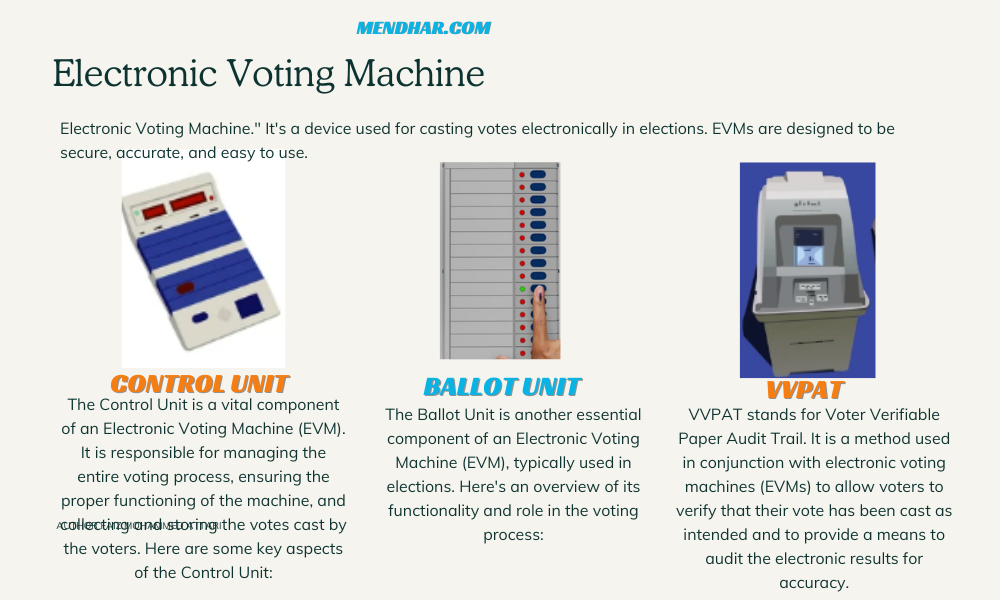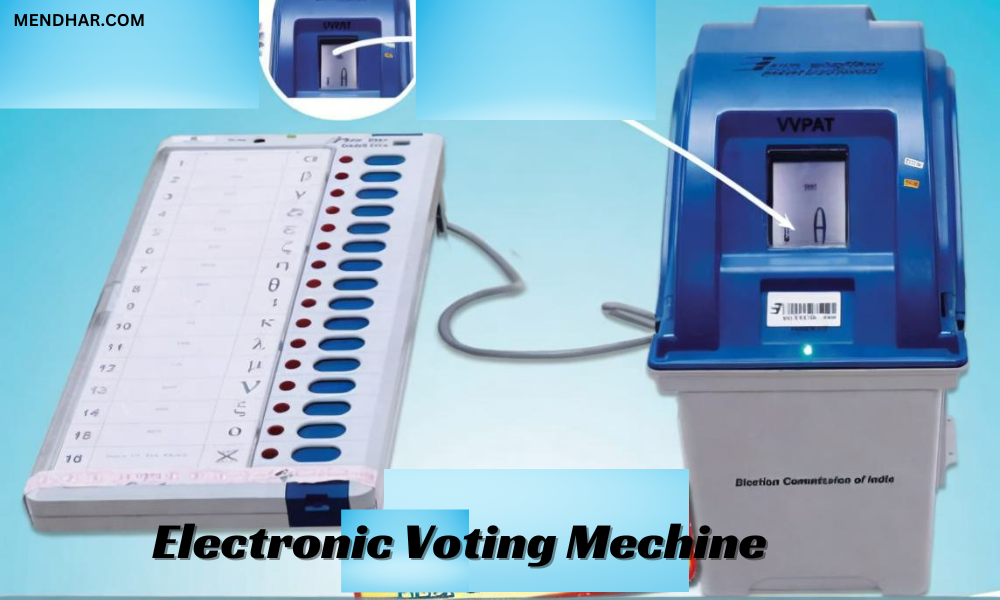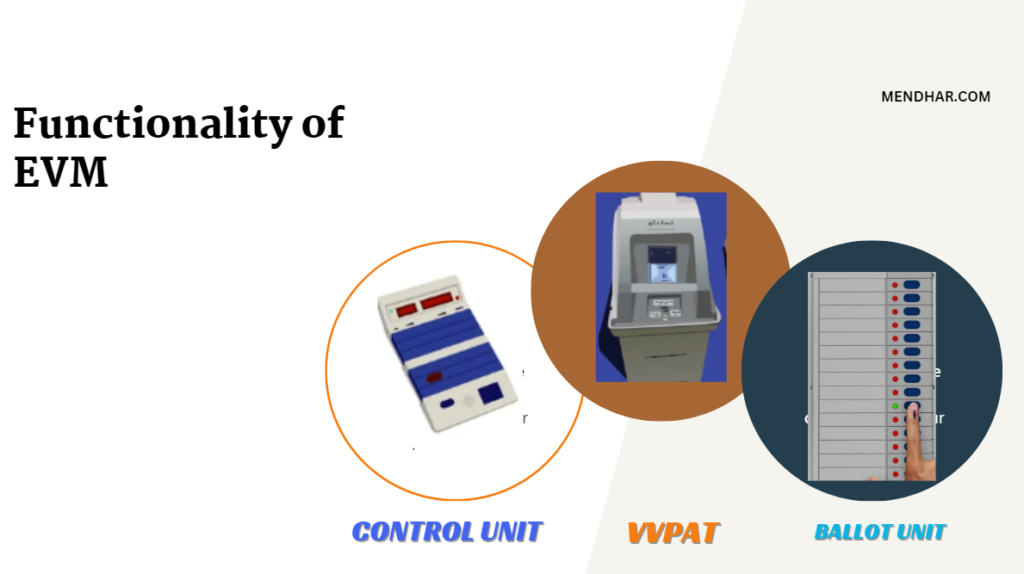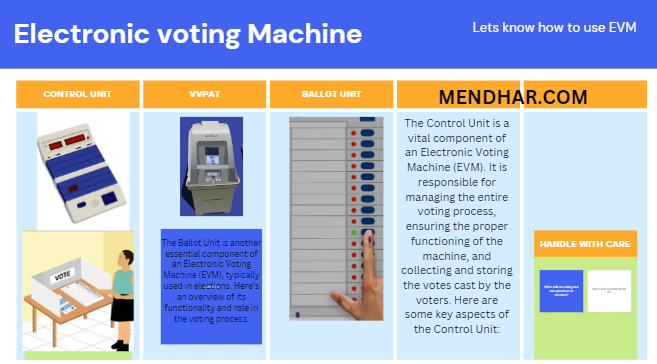
Table of Contents
ToggleIntroduction of Electronic Voting Machines (EVMs):
In the ever-evolving landscape of electoral processes, Electronic Voting Machines (EVMs) stand as a testament to the integration of technology into the fundamental exercise of democracy. These sophisticated devices have revolutionized the way elections are conducted, offering speed, accuracy, and efficiency in recording and tallying votes. From their inception to widespread adoption, EVMs have sparked debates, undergone rigorous scrutiny, and continually evolved to meet the evolving needs of electoral systems worldwide.
EVMs replace traditional paper ballots with electronic interfaces, enabling voters to cast their votes by simply pressing a button corresponding to their chosen candidate. This transition has significantly reduced the time and resources required for counting votes, minimizing errors and eliminating the possibility of invalid ballots due to unclear markings.
Initially introduced to address issues of ballot stuffing, booth capturing, and counting errors, EVMs have since become integral components of electoral processes in numerous countries. Their adoption has been driven by a quest for greater efficiency, transparency, and integrity in elections, as well as a desire to enhance accessibility for voters with disabilities.
However, the journey of EVMs has not been without controversy. Concerns over security vulnerabilities, tampering, and the need for voter-verifiable audit trails have prompted ongoing debates and calls for enhanced safeguards. Electoral authorities, technologists, and civil society organizations continue to work together to address these challenges and ensure the trustworthiness of EVMs as the cornerstone of democratic elections.
In this era of digital transformation, understanding the intricacies of Electronic Voting Machines is essential for citizens, policymakers, and electoral authorities alike. As we delve deeper into the mechanics, security measures, and implications of EVMs, we embark on a journey to uphold the principles of democracy while embracing the possibilities offered by technological innovation.
Tender Vote: through Electronic Voting Machines (EVMs)
A tender vote is cast when a voter approaches the polling booth claiming that their vote has already been cast by someone else. In such cases, the presiding officer records the vote as a tender vote, and it remains in a separate envelope. These votes are later examined by the Election Commission to verify their authenticity and ensure no duplicate votes are counted.
What is the procedure for casting a tender vote?
Casting a tender vote typically occurs in situations where a voter claims that their vote has already been cast by someone else, either mistakenly or fraudulently. Here’s a general guide on how the process of casting a tender vote may unfold:
1. Approach the Presiding Officer:
– Inform the presiding officer at the polling booth that you believe your vote has been cast by someone else. Ensure that you have valid identification to verify your identity.
2. Verification of Claim:
– The presiding officer will verify your claim by checking the electoral roll and confirming whether your vote has already been recorded or not.
3. Recording the Tender Vote:
– If the presiding officer confirms that your vote has indeed been cast, they will record your claim as a tender vote. This is typically done by filling out a tender vote form or making a note of the incident in a register designated for such cases.
4. Sealing and Securing the Vote:
– The presiding officer will then seal your tender vote in a separate envelope or container, clearly marking it as a tender vote. This is done to ensure that the vote remains distinct from regular votes cast during the election.
5. Documentation:
– The presiding officer may ask you to provide additional information or fill out a declaration form regarding the circumstances of your tender vote. This documentation helps maintain transparency and accountability in the electoral process.
6. Submission to Election Authorities:
– At the end of the voting period, all tender votes, along with their accompanying documentation, are submitted to the election authorities for further scrutiny and verification.
7. Verification and Inclusion in the Count:
– Election officials carefully examine each tender vote to determine its validity and authenticity. If the claim is deemed legitimate, the tender vote is included in the final count after thorough verification.
It’s important to note that the process of casting a tender vote may vary slightly depending on the electoral regulations and procedures in place in your jurisdiction. Additionally, tender votes are subjected to rigorous scrutiny to prevent abuse or misuse of the process, ensuring the integrity and fairness of the electoral outcome. If you believe you need to cast a tender vote, always consult with the presiding officer or election officials at your polling booth for guidance on the specific procedures to follow.

Challenge Vote: through Electronic Voting Machines (EVMs)
A challenge vote is cast when a voter’s identity is challenged by the polling agents or the presiding officer. This could happen if there are doubts about the eligibility of the voter to cast their ballot. Challenge votes are recorded separately and are subject to scrutiny by the Election Commission before being included in the final count.
What is the procedure for casting a challenge vote?
The procedure for casting a challenge vote typically involves the following steps:
1. Identification: Present yourself to the appropriate authority at the polling station or voting location.
2. Request: Inform the election official that you wish to cast a challenge vote.
3. Explanation: Provide a valid reason or explanation for why you are casting a challenge vote. This could include concerns about the eligibility of another voter or irregularities in the voting process.
4. Documentation: If required, complete any necessary forms or provide supporting documentation to support your challenge vote.
5. Verification: The election official will review your request and may ask for further clarification or evidence before proceeding.
6. Casting the Vote: Once your challenge vote is accepted, you will be provided with a ballot or directed to the appropriate voting method to cast your vote.
7. Record Keeping: The details of the challenged vote, including the reason for the challenge, may be recorded for reference and review.
8. Follow-Up: In some cases, you may be contacted for further information or asked to testify regarding your challenge vote during any subsequent investigation or review process.
It’s essential to follow the specific guidelines and procedures outlined by the electoral authorities in your jurisdiction when casting a challenge vote.

Control Unit of Electronic Voting Machines (EVMs)
In the context of an Electronic Voting Machine (EVM), the control unit is a critical component responsible for overseeing and managing the entire voting process. Here’s how the control unit operates within an EVM:
1. Initialization: The control unit initializes the EVM before the voting process begins. This includes verifying the integrity of the hardware and software components, resetting counters, and preparing the machine for voting.
2. Voter Authentication: The control unit facilitates the process of voter authentication, ensuring that only eligible voters are allowed to cast their votes. This may involve verifying voter identification cards or using biometric authentication methods, depending on the voting system in place.
3. Ballot Display: Once a voter is authenticated, the control unit activates the display screen or interface where the ballot options are presented. It ensures that the ballot is displayed clearly and accurately, allowing voters to make their selections.
4. Vote Casting: The control unit coordinates the process of casting votes. It records the choices made by voters, ensures that each vote is counted only once, and maintains the secrecy and integrity of the voting process.
5. Security: The control unit implements various security measures to safeguard the integrity of the voting data and prevent tampering or unauthorized access. This includes encryption of data, physical security mechanisms, and monitoring for any irregularities or attempted breaches.
6. Vote Tallying: After the voting period concludes, the control unit oversees the tallying of votes. It aggregates the recorded votes from all voting machines, verifies the results, and generates reports or summaries of the election outcomes.
7. Auditability: The control unit ensures that the EVM maintains audit trails and records of all voting activities. This allows for verification and auditing of the election results to ensure transparency and accuracy.
Overall, the control unit in an EVM plays a crucial role in ensuring the smooth operation, security, and integrity of the voting process, from voter authentication to result tallying.

Ballot Unit of Electronic Voting Machines (EVMs)
- The ballot unit is the part of the EVM where the voter casts their vote by pressing the button corresponding to their chosen candidate. It contains a list of candidates and their respective party symbols. The ballot unit is connected to the control unit and transmits the voter’s choice for storage and tallying.
VVPAT (Voter Verifiable Paper Audit Trail):
- VVPAT is a mechanism introduced to enhance the transparency and credibility of EVMs. It provides a printed paper trail of the voter’s choice, allowing them to verify if their vote has been accurately recorded. VVPAT enables voters to cross-check their selections and serves as a backup in case of disputes or recounts.
EVM Hackathon:Electronic Voting Machines (EVMs)
- An EVM hackathon is an event organized by electoral authorities to test the security and integrity of EVMs. Participants, including experts, technologists, and representatives from political parties, are invited to attempt to hack into EVMs under controlled conditions. These events help identify vulnerabilities and strengthen the safeguards of EVMs against tampering or manipulation.
Mock Poll in Electronic Voting Machines (EVMs)
- A mock poll is conducted before the actual voting begins to ensure that the EVMs are functioning correctly. Polling agents representing various candidates cast test votes to verify the accuracy and reliability of the EVMs. Mock polls help identify any technical issues or discrepancies that need to be addressed before the start of the election.
Understanding these essential terms related to EVMs is crucial for ensuring transparency, fairness, and confidence in the electoral process. As technology continues to evolve, it’s imperative to stay informed about the intricacies of EVMs and their role in shaping democratic elections.




Informative
Informative
Very informative
Thanks